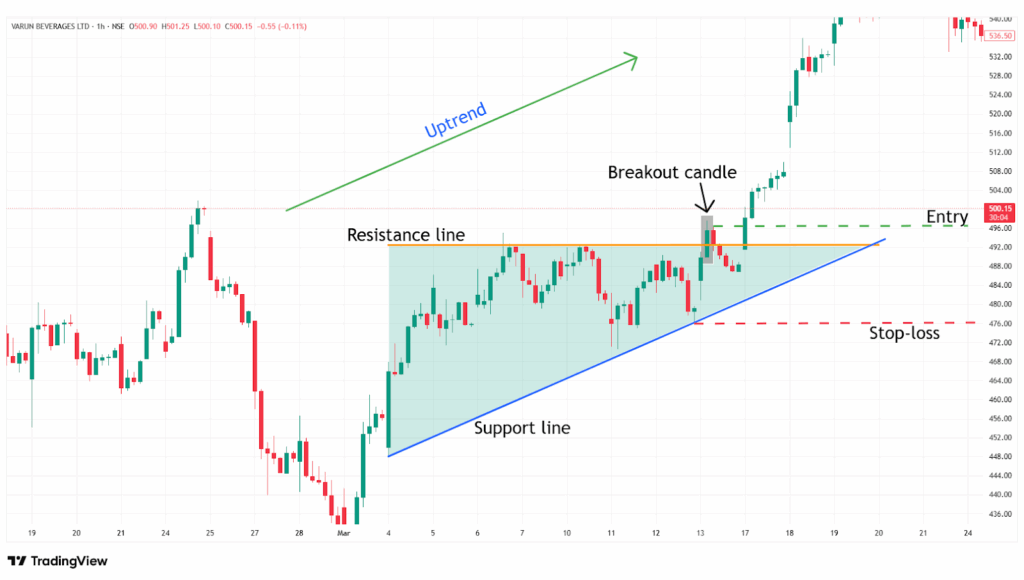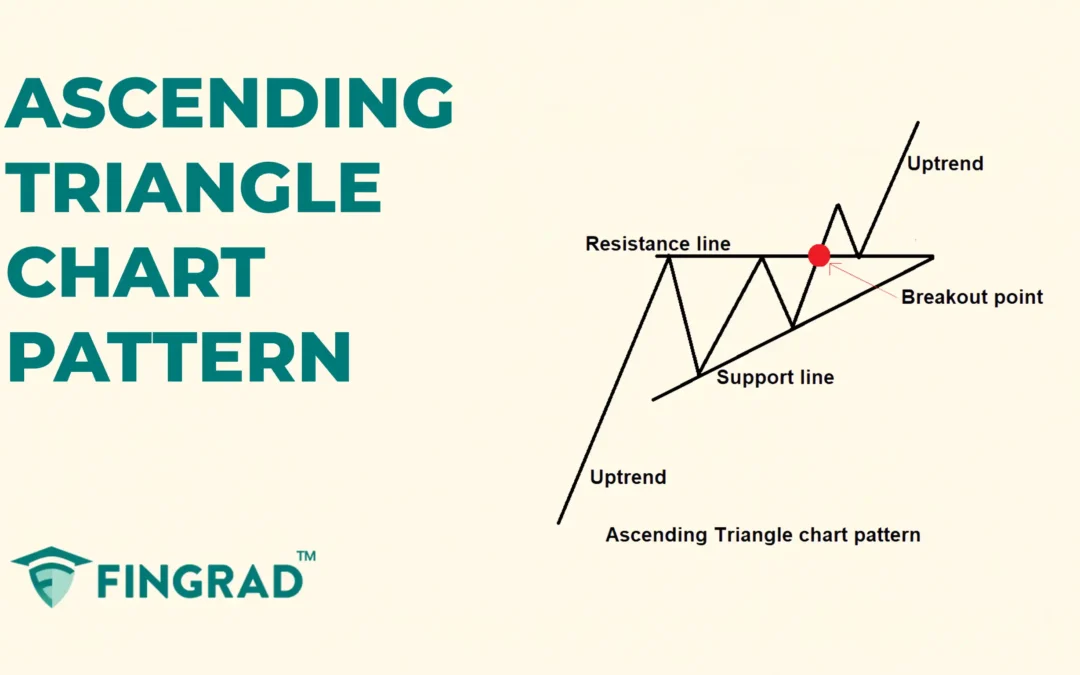When you begin trading, you will want to identify the potential reversal and continuation of an ongoing trend. Then, you must learn about the powerful chart pattern that helps traders identify potential trend reversals, making it easy for you to trade the security, as it gives a better understanding of the market sentiment and price action. Among the most reliable bullish continuation patterns is the Ascending Triangle chart pattern, especially during the market’s ongoing uptrend.
In this article, we will understand the Ascending Triangle chart pattern, its structure, how to identify it, how to trade it with an example, its advantages, and disadvantages.
What is the Ascending Triangle chart pattern?
The Ascending Triangle pattern is a consolidation pattern formed when the price moves within two converging trendlines before a strong bullish breakout and continuation of the bullish trend. Two converging trendlines define the range; the line above is the resistance line, and the line below is the support line in an ongoing uptrend.
Once this consolidation of the price is over, the price typically breaks out to begin a strong bullish trend after the pattern is formed.
The Ascending Triangle pattern can form over days, weeks, or even months, depending on the price action.
Structure
- Converging Trendlines: On the price chart, two trendlines are drawn in an ongoing uptrend.
- Upper trendline (Resistance line): A flat or horizontal line is drawn by connecting a series of highs.
- Lower trendline (Support line): The lower trendline slopes upward, connecting a series of higher lows.
The price should touch each trendline at least two to three times for a valid pattern.
- Interpretation: After a strong uptrend, the pattern is formed, indicating a bullish continuation pattern, showing that buyers are stepping in aggressively to push the prices to their high.
- Breakout Confirmation: The pattern breakout is confirmed only when the bullish candle closes above the resistance line of the pattern.

How to identify the Ascending Triangle chart pattern?
First, identify a security in an uptrend. Wait for a pullback in the price. As the price forms higher lows, draw two trendlines connecting them, one flat or horizontal resistance line on top and one ascending support line below, which converge toward a point, forming a triangle.
During the consolidation, the trading volume decreases, signalling uncertainty in price action and reduced volatility of the security.
Wait for a breakout candlestick: The pattern is confirmed when the price closes above the resistance line, and the signal to trade the security in an upward direction.
How to trade the Ascending Triangle chart pattern?
Buy signal:
Entry:
- Enter a long position in the security at the close of the breakout candle from the resistance line of the pattern formed.
Stop-loss:
- Place the stop-loss at the low of the most recent swing bottom within the triangle.
Target:
- Measure the height of the triangle at its widest point, project that distance from the breakout point, and set the target.
Target Price = Breakout Price + (Height of the Triangle)
- Set your target according to your risk-reward ratio of 1:1, 1:2, or higher, according to your trading strategy.
Example:
The chart below shows an example of “ Varun Beverages Ltd” stock at a 1-hour timeframe from 4th to 13th March 2025, and you can see the buy signal generated by the Ascending Triangle chart pattern.

What are the advantages of the Ascending Triangle chart pattern?
- The Ascending Triangle is one of the highly reliable bullish continuation patterns in technical analysis.
- The trendline of the Ascending Triangle acts as a strong support after the breakout of the pattern.
- The Ascending Triangle provides a clear entry, stop-loss, and target for everyone.
- The Ascending Triangle is versatile across all timeframes and all other security markets, and as a single strategy, can be applicable for all markets.
What are the disadvantages of the Ascending Triangle chart pattern?
- False breakouts can happen in an Ascending Triangle when the price moves below the trendline with low volume, and then it quickly reverses, especially during a sideways market.
- By the time the Ascending Triangle confirms, much of the move may have already happened.
- The Ascending Triangle often takes a long time to develop, especially on higher timeframes.
In Closing
In this article, we explored the Ascending Triangle chart pattern, its structure, how to identify it, how to trade it, along with an example, its advantages, and disadvantages.
The Ascending Triangle chart pattern is a powerful tool that signals potential bullish continuation in the ongoing uptrend, indicating multiple opportunities for clear entry and exit signals.
Your profitability depends on your approach to the trade, your risk management, and your mindset when you are holding the trade, as no indicator or tool is 100% accurate, and as the Ascending Triangle chart pattern’s efficiency and accuracy increase rapidly when it is combined with additional indicators or tools (RSI, MACD, or others).


